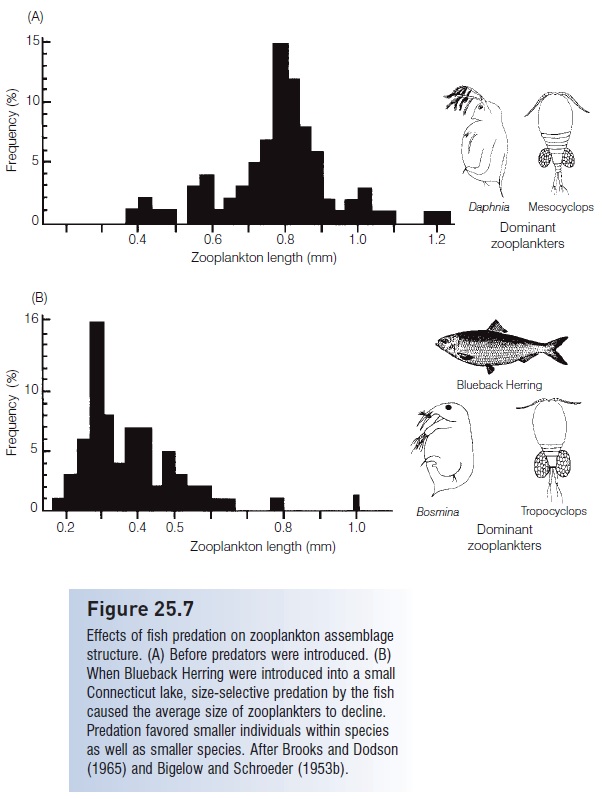Chapter: The Diversity of Fishes: Biology, Evolution, and Ecology: Communities, ecosystems, and the functional role of fishes
Effects of fishes on zooplankton
The effects of fishes on invertebrate activity, distribution, and abundance
Effects on zooplankton
The influence that fishes have on invertebrate prey populations in fresh water differs according to habitat . Although exceptions occur, fishes in general have a strong and direct influence on water column prey such as zooplankton, and a lesser and sometimes undetectable influence on benthic invertebrate populations. Fishes generally crop no more than 5–10% of zooplankton production annually, although the impact can be much greater, as when Alewives and Yellow Perch consumed 97% of the zooplankton in Lake Michigan in 1984 (Evans 1986). Fish predation on planktonic organisms normally causes a shift in size and species composition in freshwater zooplankton communities. Sizeselective predation is a general phenomenon because fish prefer larger zooplankton. Larger zooplankton are caught preferentially by particulate feeding fishes that select individual prey visually. Large zooplankton are themselves predators on smaller zooplankters. In freshwater ponds and lakes that contain zooplanktivorous fishes, the zooplankton community will be dominated numerically by small-bodied cladocerans and rotifers (Bosmina, Scapholebris, Ceriodaphnia) because they are not eaten by the fishes and their chief predators have been eliminated. When zooplanktivorous fishes are absent, larger zooplankton (e.g., large copepods and cladocerans,Daphnia spp., Simocephalus) abound and feed on the smaller zooplankton and phytoplankton (Brooks & Dodson 1965; Janssen 1980; Zaret 1980; Newman & Waters 1984; Northcote 1988) (Fig. 25.7).
For size-selective predation to occur, a fish must be able to assess prey size and correct for distance in the threedimensional, forward projecting hemisphere over which it normally searches. How this is accomplished is an area of active research. Fish size comes into play, with young fishes being apparently unable to detect small prey, whereas larger individuals have better acuity. In Bluegill Sunfish, 6 cm long fish can see objects half the size that 3.5 cm fish can detect. Some evidence indicates that apparent rather than absolute prey size may be important. When offered prey of different sizes at different distances, Bluegill, White Crappie, and sticklebacks chose the apparently larger prey, i.e., they preferred a smaller but nearer prey over a larger prey that was farther away and therefore appeared to be smaller (Hairston et al. 1982; O’Brien 1987).
Zooplanktivorous fishes cause other shifts in the ecology of their prey. Diel vertical migrations are probably a means of avoiding visually hunting fishes; plankters occur in deep, dark, cold, and relatively deoxygenated regions of lakes by day and rise into surface waters at night to feed. The extent of such migrations decreases when predation pressure from fishes is reduced. Adjustments in life history traits of prey include reductions in age at sexual maturity and average size of offspring. Predation also affects prey morphology and coloration. Some cladocerans (e.g., Daphnia) develop neck spines when exposed to water that has contained Bluegill. Some cladocerans are relatively dark when occurring in fish-free ponds, but are essentially transparent when co-occurring with fish in lakes; copepods are red in the absence of fish but take on a less vulnerable pale green color in ponds containing fishes.

Figure 25.7
Effects of fish predation on zooplankton assemblage structure. (A) Before predators were introduced. (B) When Blueback Herring were introduced into a small Connecticut lake, size-selective predation by the fish caused the average size of zooplankters to decline. Predation favored smaller individuals within species as well as smaller species. After Brooks and Dodson (1965) and Bigelow and Schroeder (1953b).
The costs of coloration are obvious from studies that show that some fishes will take the smaller of two forms if it is more pigmented, or will take prey with the large dark eyes over similar size prey with smaller eyes (Zaret 1980; Lazzaro 1987; O’Brien 1987; Walls et al. 1990; Hobson 1991).
Studies in temperate and tropical nearshore marine environments also suggest a strong influence of zooplanktivorous fishes on species composition and size structure of prey populations. Small (<1 mm), transparent zooplankters that are part of the pelagic community that is being carried by currents (e.g., dispersing fish eggs and larvae, small copepods, larvaceans) characterize the water column and fish diets during the day. The fishes tend to aggregate at the upcurrent edges of reefs and other structures, where they intercept the incoming pelagic forms. Densities of plankton are lower in downcurrent areas, indicating that fishes remove a significant number of plankters from the water column. At night, different species and sizes of zooplankters occur than are seen during the day. Larger, opaque animals (1–10 mm), such as mysids, large copepods, polychaete worms, amphipods, ostracods, and crustacean larvae, emerge from the substrate or migrate vertically upward and join the small, transient zooplankters.
Both groups encounter a different set of predators at night, generally large-mouthed fishes with large eyes (e.g., squirrelfishes, cardinalfishes, sweepers). Vision is the most widely used detection mode both by day and night, but nocturnal zooplanktivores are constrained by the lack of light, making it safer for larger zooplankton that would be easily detected during the day (small plankters are seldom found in the stomachs of nocturnal fishes). Verifi cation of the influence of predators on oceanic plankton communities would require the kinds of predator removal or enclosure experiments that have been performed in fresh water, but the open nature of oceanic coastlines and the longdistance dispersal of the prey make these kinds of experiments virtually impossible (Bray 1981; Hobson et al. 1981; Hobson 1991).
Related Topics